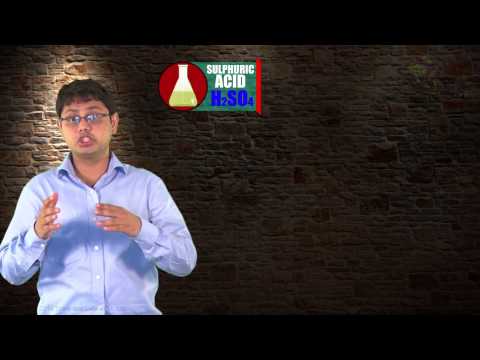What are Strong Acids and their List?
A total of seven acids are widely regarded as “strong” acids in the field of chemistry. The list of strong acids is provided below.
- Hydrochloric acid (denoted by the chemical formula HCl)
- Hydrobromic acid (denoted by the chemical formula HBr)
- Hydroiodic acid or hydriodic acid (denoted by the chemical formula HI)
- Sulfuric acid (denoted by the chemical formula H2SO4)
- Nitric acid (denoted by the chemical formula HNO3)
- Chloric acid (denoted by the chemical formula HClO3)
- Perchloric acid (denoted by the chemical formula HClO4)
These acids are classified as strong acids because they (almost) completely dissociate into their constituent ions, which includes their anionic conjugate base and a proton, when they are dissolved in water.
Recommended Videos
What are Acids, Bases and Salts?

Uses of Acids and Bases

1. Hydrochloric Acid (HCl)
Hydrochloric acid, also known as muriatic acid, is a chemical compound with the formula HCl. This compound is a colourless, inorganic acid. Hydrochloric acid is known to have a very pungent odour. It is also known to be highly acidic and has the ability to attack and cause damage to the skin.
Hydrochloric acid is considered to be the simplest acidic system that contains chlorine and water. Hydrochloric acid is nothing but a solution of hydrogen chloride mixed with water. However, this system is known to contain a number of other chemical compounds such as the chloride ion and the hydronium ion. This acidic system is known to be a natural component of the gastric acid that is formed in the digestive tracts of almost all animal species. Even the digestive systems of human beings are known to naturally produce hydrochloric acid in order to aid the digestion of the consumed food.
2. Hydrobromic Acid (HBr)
Hydrobromic acid is a very solid acid which is formed when hydrogen bromide (a diatomic molecule consisting of one hydrogen atom and one bromine atom) is dissolved in water. Hydrobromic acid has an acid dissociation constant (often denoted by the symbol pKa) of magnitude −9. This implies that hydrobromic acid is a stronger acid when compared to hydrochloric acid. However, this acid is not known to be as strong as hydroiodic acid when it comes to acidic strength. It can be noted that hydrobromic acid is one of the most potent known mineral acids.
Hydrobromic acid is used primarily for the production of certain inorganic bromides, especially calcium, zinc and sodium bromides. This compound is a very good reagent for the processing of organobromine compounds. Several ethers are cleaved with HBr. This compound also catalyzes certain alkylation reactions that have applications in the extraction of ores.
3. Hydroiodic Acid (HI)
Hydroiodic acid (sometimes referred to as hydriodic acid) is an extremely acidic solution of hydrogen iodide and water. This compound is known to be the second strongest acid of hydrogen and a halogen (the strongest being hydrostatic acid). Hydroiodic acid is a widely used chemical reagent. This compound has the ability to completely ionize when placed in an aqueous solution.
Under standard conditions for temperature and pressure, this compound exists as a colourless liquid which has a slightly acrid odour. The density of hydroiodic acid is approximately equal to 1.7 grams per millilitre under standard conditions. This acid is known to have a boiling point of 400 Kelvin or 127 degrees Celsius.
4. Sulphuric Acid (H2SO4)
Sulphuric acid (sometimes spelt as sulphuric acid and sometimes referred to as vitriol oil or oil of vitriol) is a mineral acid consisting of oxygen, sulphur and hydrogen. The molecular formula of this compound can be written as H2SO4. This acid is a colourless and odourless liquid which is highly viscous in nature. It can also be noted that sulphuric acid is water-soluble and is usually synthesized in highly exothermic reactions.
The corrosiveness of this compound can be attributed mainly to its strong acidic nature (and also its oxidizing properties when it is kept at high concentrations). Sulphuric acid is also known to be hygroscopic. It absorbs water vapour from the air readily. It is important to note that sulphuric acid can cause serious chemical burns on contact and even secondary thermal burns. This is the reason why, even at lower concentrations, it is thought to be very dangerous.
5. Nitric Acid (HNO3)
Nitric acid (denoted by the chemical formula HNO3), also referred to as the spirit of nitre and sometimes as aqua fortis, is an extremely corrosive mineral acid. This compound is a very powerful oxidizing agent and is widely used in nitration reactions that involve the addition of a nitro group to a given reactant.
The molar mass of nitric acid corresponds to 63.01 grams per mole. Under standard conditions for temperature and pressure (usually abbreviated to STP), this compound exists as colourless, yellow, or yellowish-red liquid. This mineral acid is known to have an extremely suffocating, acrid odour associated with it. It can be noted that this compound has a melting point of 231 Kelvin and a boiling point of 394 Kelvin.
6. Perchloric Acid (HClO4)
Perchloric acid, a chemical compound with the formula HClO4, is a very powerful mineral acid. This compound is a colourless substance which is usually used in an aqueous solution. It can be noted that perchloric acid is a stronger acid than sulphuric acid and nitric acid. When kept in a dry form, this compound is a very potent oxidizer.
Perchloric acid has many stringent regulations associated with its handling due to its extremely powerful oxidizing properties. For metals (such as aluminium) and organic matter (such as wood and also certain plastics), this acid is highly reactive. This is the reason why research performed with perchloric acid must always be carried out with the help of fume hoods.
7. Chloric Acid (HClO3)
Chloric acid is a chemical compound with the formula HClO3. This compound is an oxoacid of chlorine and is highly acidic in nature. Chloric acid is also known to be a very powerful oxidizing agent. The molar mass of this compound is 84.45 grams per mole. It is important to note that chloric acid is considered to be thermodynamically unstable since it tends to readily undergo disproportionation. However, when this compound is placed in aqueous solutions in concentrations not exceeding 30% and in relatively cold environments, it is considered stable.
Frequently Asked Questions – FAQs
What is meant by strong acid?
Solid acids in the solution completely dissociate into ions. Hydrochloric acid, for example, is a solid acid. It ionises completely to form ions of hydrogen and ions of chloride. Strong acids also contain nitric acid and sulfuric acid.
What pH does a weak acid have?
The pH will be less than 7 (not neutral) for a weak acid and is typically greater than the value for a strong acid. Notice that exceptions occur. For instance, for a 1 mM solution, the pH of hydrochloric acid is 3.01, while the pH of hydrofluoric acid is very low, with a value of 3.27 for a 1 mM solution.
How can you tell a strong acid?
Every acid 100 % dissociated into ions is considered a solid or strong acid. If it does not dissociate 100 % , it is a weak acid.
Which is king of acid?
At concentrations of 78, 93, or 98 percent, sulfuric acid is usually supplied. Sulfuric acid is often referred to because it is generated as the “king of chemicals”. Pure anhydrous sulfuric acid does not occur in nature as a result of its affinity for water.
Is HCl a weak acid?
Hydrogen chloride (HCl) ionises fully in water into hydrogen ions and ions of chloride. A weak acid is an acid which in an aqueous solution ionises only slightly. Acetic acid (found in vinegar) is a weak acid and is very common. Since HCl is a heavy acid, it is extremely weak in its conjugate base (Cl−).
To learn more about strong acids and other important concepts related to acids and bases, register with BYJU’S and download the mobile application on your smartphone.


Comments